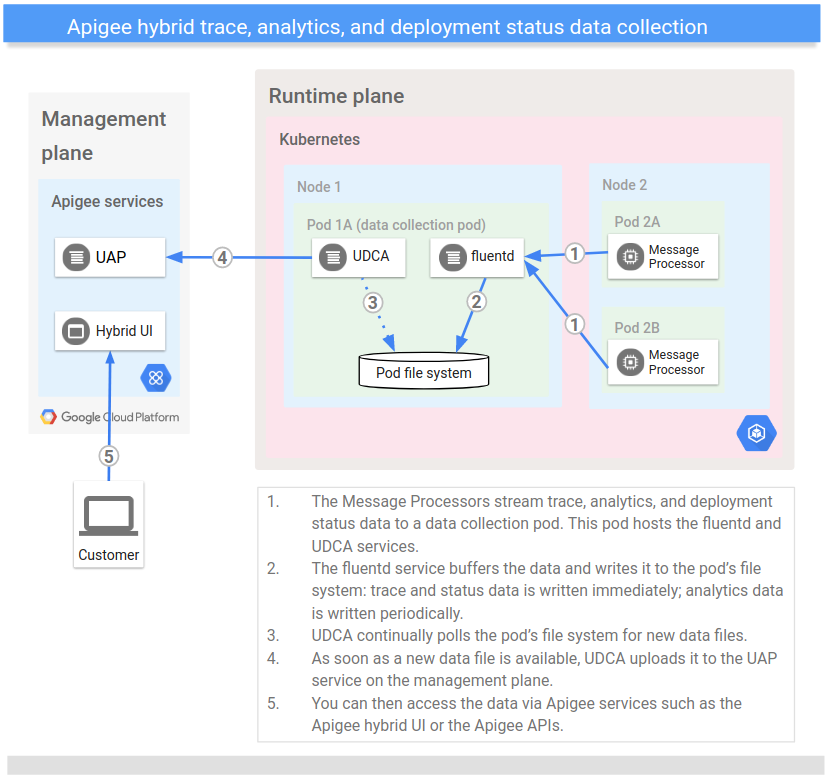Apigee Hybrid stellt Debugging-, Analyse- und Bereitstellungsstatusdaten zur Verfügung. Diese Daten werden von einem Datenerhebungs-Pod erhoben und an die Verwaltungsebene gesendet. So können Sie die Daten anzeigen und analysieren sowie Monitoring und Benachrichtigungen einrichten.
Über die Daten
Alle MP-Dienste (Message Processor) in Hybrid streamen Debugging- (falls initiiert), Analyse- und Bereitstellungsstatusdaten über TCP an einen Datenerhebungs-Pod im Cluster. Der Datenerhebungs-Pod speichert die gestreamten Daten über einen fluentd-Dienst im Dateisystem des Pods.
Der UDCA (Universal Data Collection Agent) extrahiert die gespeicherten Daten regelmäßig und sendet sie auf der Verwaltungsebene an den UAP-Dienst (Unified Analytics Platform). Der UAP verarbeitet die eingehenden Analyse- und Bereitstellungsstatusdaten und stellt sie Ihnen über die Hybrid-Benutzeroberfläche oder die Apigee APIs zur Verfügung.
Apigee Hybrid implementiert den Datenerhebungs-Pod als ReplicaSet mit mindestens zwei Replikaten.
Die folgende Abbildung demonstriert die Erhebung der Debugging-, Analyse- und Bereitstellungsstatusdaten:

Die Debugging-, Analyse- und Bereitstellungsstatusdaten werden nicht am selben Ort gespeichert und nicht auf dieselbe Art wie Logging- und Messwertdaten abgerufen:
- Logging- und Messwertdaten werden in Ihrem Google Cloud-Projekt gespeichert und über ein Tool wie Cloud Operations oder einem anderen Tool Ihrer Wahl aufgerufen.
- Debugging-, Analyse- und Bereitstellungsstatusdaten werden andererseits in der Hybrid-Verwaltungsebene gespeichert und über Apigee-Dienste wie die Hybrid-UI oder Apigee-APIs abgerufen.
Folgende Tabelle fasst die vom Datenerhebungs-Pod erfassten Daten zusammen:
| Datentyp | Dataset-Name | Beschreibung | Aktualisierungsrate | APIs |
|---|---|---|---|---|
| Analysen | api |
API-Nutzungsdaten, einschließlich Transaktionen pro Sekunde, Cache-Nutzung, Fehler, Latenzen, Anfrage-/Antwortgrößen und Trafficzahlen. Weitere Informationen finden Sie in der Apigee Analytics-Übersicht. |
Bis zu 30 Sekunden Verzögerung | Analytics Admin API |
| Bereitstellungsstatus | event |
Der aktuelle Deploymentstatus des API-Proxys. Weitere Informationen zur Anzeige dieser Informationen finden Sie unter Deploymentstatus aufrufen. |
Sofort | Bereitstellungs-API |
| Fehlerbehebung | debug |
Debuggen Sie Sitzungsdaten für API-Proxys. Dazu gehören die Anfrage-/Antwortparameter sowie die Transformationen, die während der Richtlinienausführung angewendet werden. Aufgrund der Größe werden Debugging-Daten im Gegensatz zu Analyse- und Bereitstellungsstatusdaten nicht immer erhoben. Debugging-Daten werden dann erhoben, wenn Sie eine Debugging-Sitzung starten. Weitere Informationen finden Sie unter Debugging. |
Sofort | Fehlerbehebung zur Sitzungs-API Fehlerbehebung zur Sitzungsdaten-API |
Daten in der Hybrid-Benutzeroberfläche ansehen
In diesem Abschnitt wird beschrieben, wie Sie die Debugging-, Analyse- und Bereitstellungsstatusdaten in der Apigee Hybrid-Benutzeroberfläche ansehen.
Fehlerbehebung
Auf Debugging-Daten für Hybriddienste kann auf dieselbe Weise zugegriffen werden wie auf Edge-Debugging-Daten. Es gibt aber einige Unterschiede, z. B. eine erweiterte Filterunterstützung. Weitere Informationen finden Sie unter Debugging.
Analysen
Analytics-Daten für Hybriddienste sind auf dieselbe Weise zugänglich wie Edge-Analysedaten. Weitere Informationen finden Sie unter Verwendung der Analyse-Dashboards in der Edge-Dokumentation.
Proxy-Deploymentstatus
Informationen zum Anzeigen des Deploymentstatus finden Sie unter Bereitstellungsstatus aufrufen.
Datenerhebung konfigurieren
Zum Festlegen, wie und wo Debugging-, Analyse- und Bereitstellungsstatusdaten im Datenerhebungs-Pod erhoben werden, konfigurieren Sie den UDCA über die Konfigurationsattribute. Die UDCA-Attribute umfassen allgemeine Attribute und auch Dataset-spezifische Attribute.
So konfigurieren Sie den UDCA:
- Öffnen Sie die Datei
overrides.yamlzur Bearbeitung auf Ihrem Kubernetes-Verwaltungssystem, wie unter Komponenten der Laufzeitebene verwalten beschrieben. - Bestimmen Sie die Werte der UDCA-Konfigurationseinstellungen. Sie können benutzerdefinierte Werte für UDCA-Attribute festlegen, z. B.:
- Abfrageintervall
- Anzahl der Replikate (min. und max.)
- Prozentualer CPU-Zielwert, der zusätzliche Replikate auslöst
Eine vollständige Liste der anpassbaren UDCA-Attribute finden Sie unter
udca. - Speichern Sie Ihre Änderungen in der Datei overrides.yaml.
-
Wenden Sie Ihre Änderungen an, indem Sie das Diagramm
apigee-envaktualisieren.helm upgrade ENV_NAME apigee-env/ \ --namespace apigee \ --set env=ENV_NAME \ --atomic \ -f overrides.yaml

